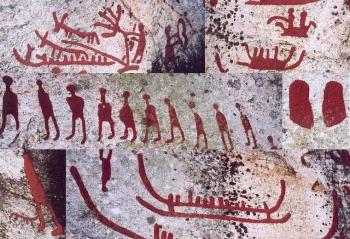Zkribbler
Deity
Genetic markers indicate that, just before the dawn of civilization, a generations-long world war killed off 19 out of every 20 men. 

Genetics can reveal many buried secrets. An extramarital dalliance. The origins of our ancestors. In this case, it may have revealed that men almost exterminated themselves some 7,000 years ago.
The genetic indicators have been there for some time. It’s called the “Neolithic Y chromosome bottleneck.”
It’s a point in our stone-age past when our genetic diversity suddenly choked. At least among the male-transmitted genes. After a period of some 2,000 years of decline, there was only one fertile male left alive to mate with every 17 women.
It’s an event recorded in the bloodlines that have emerged across the world.
Previously, academics felt this may have had something to do with the way our ancestors explored and settled new lands. It was called the “founder effect,” where a small number of individuals keep moving to establish new settlements.
But a new study published in the science journal Nature puts forward a much more brutal proposal.
Men killed most of their peers off.
Cauldron of change
Europe, Asia, Africa and the Middle East may have been consumed by carnage between 5,000 and 7,000 years ago. And, as fathers pass their Y chromosome on to their sons, entire families must have been exterminated over wide areas.
It was a time when the world population is estimated to have been somewhere between five and 20 million people. To leave such a stark genetic imprint behind, as many as 9.5 million men must have been killed.
Why?
The Stanford University team blames “competition between patrilineal kin groups.”
Otherwise known as tribalism.
Clans form from common ancestors. They establish a strong group identity. This, in turn, promotes a sense of difference and competition with separate nearby clans.
The researchers say these pressures came to a head shortly before the first civilization emerged in Sumeria about 4,000 years ago.
“The presence of such groups results in violent intergroup competition preferentially taking place between members of male descent groups, instead of between unrelated individuals,” the researchers write.
“Casualties from intergroup competition then tend to cluster among related males and group extinction is effectively the extinction of lineages.”
Essentially, the victorious clans would exterminate their opponent’s menfolk to ensure ongoing dominance and the eradication of potential competition. They would then seize the surviving women.
World War Zero?
According to the researcher’s data, the carnage would have been horrific. The slaughter was so intense that just one-twentieth of the entire male population survived.
The fighting must have persisted for generations. And the first signs of civilization arose from the ashes.
Their hypothesis goes something like this:
Human society began to evolve away from nomadic hunters towards farming communities about 12,000 years ago. Suddenly, they had possessions. Resources were finite. And as clans had begun to settle in one place, intruders were unwelcome.
Such groups evolved systems of organization based on family membership — generally focused on the male chief of the clan. In terms of chromosomes, it would have appeared as though every male member of a clan had the same father.
Wiping out a clan would wipe out their unique Y chromosome markers.
The victorious clan would then expand to fill the void left behind.,
This hypothesis is only a model. There is no direct evidence of such a world-spanning conflict. It’s possible a male-specific disease could also have caused such carnage.
But, circumstantially, such brutal clan cleansing seems feasible.

 So this morning, I tracked the source down to a study by 66 institutions, including the University of Arizona, the University of Cambridge, the University of Tartu, and the Estonian Biocentre.
So this morning, I tracked the source down to a study by 66 institutions, including the University of Arizona, the University of Cambridge, the University of Tartu, and the Estonian Biocentre.
